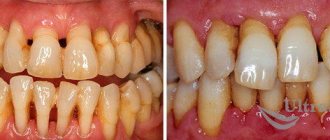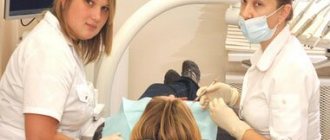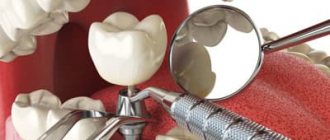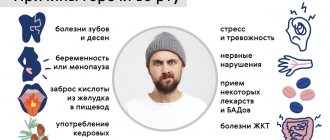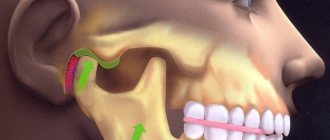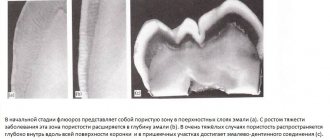Periodontal disease is a fairly rare disease of non-inflammatory origin, characterized by systemic damage to the periodontal tissues (periodontium), which is often difficult to diagnose in the early stages. Its appearance, as a rule, is associated with a hereditary predisposition or systemic diseases of certain organs.
There is often an erroneous spelling of this term - periodontal disease. In order to dispel all doubts, let us turn to the etymology, which covers two words in ancient Greek: πᾰρά (para - “near, located near”) and ὀδόντος (odóntos is the genitive case of the word ὀδούς - odus, translated means “tooth”).
Consequently, from the ancient Greek language this term is translated as “near the tooth” or “located next to the tooth.”
There are cases when even doctors mistakenly call periodontal disease a completely different disease - periodontitis, which is in fact a completely different phenomenon due not only to its inflammatory origin, but also to other features.
How does periodontal disease occur?
Periodontal disease is a systemic disease of the periodontal tissue, or periodontium. Refers to inflammatory gum diseases.
The causes of periodontal disease are pathogenic microbes living in dental plaque, under the influence of which inflammation occurs. That is, in fact, the main reason for the occurrence is insufficient oral hygiene and the constant presence of dental plaque.
Periodontal disease at the initial stage is confused with gingivitis or periodontitis.
The insidiousness of the disease is that the patient does not even suspect its presence for a long time. The gums become sensitive and begin to bleed, but all these symptoms develop over a long period of time and gradually, so from the moment of onset until the moment when the patient begins to understand that there is something wrong with the gums, time passes and the favorable moment for treatment is missed.
If periodontal disease treatment is not started in time, a periodontal pocket forms at the root of the tooth, in which pathogenic bacteria multiply and cause destruction and resorption of the root.
Classification of periodontal disease
Depending on the extent of the lesion, localized and generalized periodontal disease are distinguished. In the first case, the teeth in a certain area of the jaw suffer, and in the second, the entire upper and/or lower jaw is involved in the pathological process. The disease has a chronic course with periods of remission, during which there are no characteristic symptoms. Also in the classification of periodontal disease there are several stages or degrees:
- With a mild degree, there is a slight exposure of the neck of the tooth and a decrease in the height of the interdental septa to 1/3. The gums have a normal appearance and may be slightly pale. Pathological mobility of teeth is not noted.
- With moderate periodontal disease, the changes become more pronounced. The necks of the teeth are exposed more strongly, the height of the interdental septa is reduced to 1/2, the gums become dense and pale. In this case, gaps may appear between the teeth and slight tooth mobility may develop.
- Severe advanced periodontal disease is characterized by serious changes in the gums and teeth. The roots are almost completely exposed, severe tooth mobility appears, which causes the bite to be disrupted and the patient cannot eat solid food.
Inflammation may develop against the background of a secondary infection. In this case, they talk about purulent periodontal disease. This form of the disease requires emergency medical care.
Causes
- hereditary factor;
- the presence of a large number of pathogenic microbes;
- malocclusion;
- injuries to teeth and gums;
- the presence of common diseases, for example, diabetes, hypertension, atherosclerosis and some other diseases.
With periodontal disease, the nutrition of periodontal tissue is disrupted, resulting in changes in the structure of the gum tissue. All the causes that contribute to the occurrence of periodontal disease can be divided into two groups:
- Group 1 - general reasons;
- Group 2 - local causes.
The common causes of periodontal disease are directly related to the patient’s health status and depend on the patient’s presence of diseases of the endocrine system, cardiovascular system, gastrointestinal tract, and hypovitaminosis.
Local causes are local in nature, they depend on
- correct bite;
- development of the vestibule of the oral cavity;
- correspondence of the sizes of the frenulum of the tongue and lips;
- the presence of tartar and the intensity of dental plaque, in which pathogenic bacteria and microorganisms actively multiply.
Microbes provoke the development of an inflammatory process in the gum tissue, as a result of which the gum tissue becomes loose and gradually collapses. Microbes develop most actively in plaque and tartar, so with careful oral hygiene, the risk of developing periodontal disease is significantly reduced.
Heredity. If parents had periodontal disease, their children will most likely have a tendency to this disease, especially if pathologies of the body are discovered - chronic diseases of internal organs, diabetes, problems with the endocrine system, in particular the thyroid gland, diseases of the cardiovascular system.
Diagnosis of periodontal disease
A dentist diagnoses and treats periodontal disease. This can be either a general dentist or a more specialized specialist – a periodontist. Diagnosis begins with collecting anamnesis. The doctor clarifies what complaints the patient has, when they first appeared and what they could be associated with. After the conversation, an examination of the oral cavity is performed. The dentist pays attention to the condition of the gums and tooth enamel, determines the formation of the bite, measures the depth of the gum pockets, and notes the presence of wedge-shaped defects.
To obtain additional information, an instrumental examination is prescribed, which may include the following methods:
- targeted photographs of teeth;
- panoramic shot of the jaws;
- echoosteometry (ultrasound examination of bone tissue);
- CT scan.
A comprehensive examination allows you to determine the degree of resorption (resorption) of bone tissue, identify pathological abrasion of enamel, and assess the condition of the ligamentous apparatus of the tooth. Also, with the help of additional diagnostic methods, it is possible to identify complications and plan future treatment.
If necessary, the patient can be referred for consultation to other specialists (dental surgeon, orthodontist).
Diagnostics
Only an experienced dentist can diagnose periodontal disease, since at an early stage the symptoms are similar to those of other diseases, so it is extremely important to make a correct differential diagnosis from other diseases with similar symptoms.
When making a diagnosis, the doctor must examine the patient, carefully ask him about symptoms, well-being, and the presence of diseases, especially systemic problems with the endocrine system. You should also indicate the degree of development of periodontal disease, the depth of the gum pockets, the type of atrophy, and the degree of exposure of the necks of the teeth. All this will help to correctly identify the causes and prescribe treatment.
When diagnosing periodontal disease, a variety of functional diagnostic methods are used. With their help, it is possible to detect initial vascular changes, which makes it possible to make a diagnosis at an early stage.
- Using the modern method of rheoparodontography, it is possible to diagnose the early stage of development even in young people, when symptoms practically do not appear.
- Using the polarography method, it is possible to detect even a slight decrease in the level of oxygen in the gum tissue.
- It is impossible to make a correct diagnosis without modern X-ray examination. It is the radiograph that allows us to determine the degree of atrophy of the alveolar process, which allows us to correctly determine the stage of development.
- With periodontal disease, ROE increases, as there is constant intoxication of the entire body with decay products and vital activity of pathogenic microorganisms. The leukocyte count shifts to the left, the patient may complain of low-grade fever for a long time. Therefore, when making a diagnosis, it is also important to order a general blood test of the patient.
It should be noted that periodontal disease is a disease that lasts for years. And sometimes years pass from the appearance of the first symptom to a visit to the dentist. Therefore, doctors are often faced with advanced conditions of teeth and gums. With careful oral hygiene and following all the recommendations and instructions of the dentist, it is possible to keep teeth and gums healthy into old age.
What are the manifestations of periodontal disease?
Severe degree of disease Unfortunately, signs of periodontal disease are quite difficult to track at the early stage of the disease, since at this stage the patient does not experience pain and does not notice visible disorders that would alert him and hint that he needs to undergo an examination of the oral cavity.
At the stage when the disease begins to gain momentum, the following symptoms of periodontal disease are identified:
- gums are not inflamed; no bleeding gums are observed; no discharge of pus is observed; the teeth in the sockets (bone alveoli) are held firmly and do not become loose; There is a minimal amount of plaque on the teeth.
Wherein:
there is a decrease in the size of the alveolar processes (bone tissue, which has a spongy structure, continues the lower and upper jaws and forms sockets for teeth);
the necks of the teeth are exposed (that part of the tooth that is located between the root and the crown);
the necks of the teeth become sensitive to cold and hot, as well as various chemical irritants; patients complain of itchy gums; blood flow into the periodontal tissue decreases, the gums become paler in color.| What are the stages of periodontal disease?
At first, the disease can occur quite unnoticed. The patient only occasionally feels itching and discomfort when chewing, cases of food debris getting stuck between the teeth gradually become more frequent, then the necks of the teeth become exposed, the latter looking “longer than before.”
If these symptoms occur, it is important not to hesitate, but rather to consult a doctor to make a diagnosis and determine the causes of changes in the oral cavity. Otherwise, the disease (if it really is) may develop into another, active stage, which can lead to very tragic consequences (teeth loss, painful and lengthy treatment, other troubles).
Let's look at the different stages of this disease in more detail.
First stage (mild degree).
At this stage of development, the disease rarely manifests itself. As a rule, the first changes in periodontal tissue are asymptomatic.
Quite rarely at this stage, patients experience any unpleasant or painful sensations, itching or burning.
Second stage (middle stage).
This stage is much more visual. While brushing teeth and eating, patients notice bleeding gums. More often, food debris gets stuck between the teeth, all this indicates the development of dystrophic disorders of the interdental septa. Third stage (severe) and complications.
This stage can be characterized by the ongoing processes of destruction of periodontal tissues, which are accompanied by the appearance of inflammation, purulent ulcers, mobility and displacement of teeth develop.
A significant increase in the size of bone and periodontal pockets, which progresses at this stage of development of periodontal disease, can result in the development of other diseases and tooth loss.
Treatment
In the treatment of periodontal disease, the following modern treatment methods are used:
- Surgical.
- Orthopedic.
- Physiotherapeutic.
- Therapeutic.
The best treatment results are achieved when treatment is carried out comprehensively, using all of the above treatment methods.
- The surgical method is effective when there is a high degree of atrophy of the alveolar process. In this case, bone tissue is surgically built up, which helps keep the teeth in the right place, preventing them from becoming loose and falling out. The surgical method is also effective in the fight against periodontal (gingival) pockets.
- The orthopedic method is used when it is necessary to replace lost teeth or strengthen the fixation of those teeth that still remain. The dentist installs special crowns, bridges or dentures in the patient’s mouth.
- The physiotherapeutic method includes laser therapy and laser photophoresis. With their help, it is possible to activate blood circulation in the gum tissues and also effectively fight microbes.
- The use of therapeutic methods makes it possible to remove dental plaque and treat caries, which is an invariable companion to periodontal disease.
Additional effective methods:
- In parallel with all of the above treatment methods, the dentist must prescribe vitamin therapy , since the lack of certain vitamins and microelements in the body only intensifies the symptoms of periodontal disease. Sometimes it becomes necessary to prescribe hormonal drugs if the disease is caused by disturbances in the functioning of the endocrine system.
- During treatment, it is very important not only to adhere to the treatment regimen prescribed by the doctor, but also to use the right products for personal oral hygiene. You should brush your teeth and gums with special toothpastes developed by specialists for the treatment of periodontal disease. The presence of special ingredients in such medicinal toothpaste allows you to actively combat increased gum bleeding and inflammation. The presence of antibacterial components in toothpaste allows you to reduce the number of pathogenic bacteria in the oral cavity.
- In difficult cases, the doctor may recommend a patch operation, during which the formed inflammatory granulations and dental plaque are removed, and the cavity is treated with special antibacterial agents.
- Treatment of periodontal disease must necessarily include dental treatment, since the presence of chipped teeth, unsuitable fillings, and poor-quality dental crowns can lead to gum injury. Therefore, the doctor must eliminate all these so-called local factors at the initial stage of treatment.
- For more effective treatment, it is also necessary to increase the body’s protective functions, which leads to the prescription of restorative and anti-inflammatory drugs.
- Traditional methods of combating periodontal disease, aimed at strengthening the gums and relieving inflammation, are also quite effective. An experienced doctor will definitely advise the patient on additional traditional methods of treatment, which do not replace full treatment, but perfectly complement it.
Symptoms of the disease
The development of periodontal disease occurs at a fairly slow pace. The disease is accompanied by gradual atrophy of the alveolar processes and dystrophic changes in the bone tissue of the teeth. In this case, the roots are exposed.
Among the symptoms of periodontal disease are the following:
- susceptibility to temperature irritants, sweet and sour foods - all this appears due to the exposure of tooth roots, on which there is practically no enamel,
- pallor of gingival tissues,
- itching and burning in the gums,
- change in the beauty of the smile - the crowns of the teeth become very long. This pathology is usually called “horse smile”,
- Gaps appear between the teeth in the root area,
- teeth become mobile as the tissue around their roots decreases, because it becomes almost impossible to keep them.
If you take an OPTG - a panoramic X-ray image, then the destruction of bone tissue will be clearly visible on it, i.e. its significant loss around the roots. Moreover, throughout the entire dentition, since periodontal disease is rarely localized in the area of one tooth.
Consequences and complications
With periodontal disease, you can not only lose all your teeth, but also develop a bunch of other related diseases. As a rule, all patients with this disease suffer from diseases of the gastrointestinal tract, since the absence of teeth or severe chronic inflammation of the gums does not allow them to fully chew food, which negatively affects the health of the stomach and intestines. Therefore, you should not take this disease lightly.
Without proper treatment, periodontal disease can develop into periodontitis, and this disease is even more dangerous. The course may also be complicated by the development of ulcerative gingivitis, inflammation of the lymph nodes, the appearance of gingival abscesses, and the occurrence of osteomyelitis of the jaw.
Possible complications
If you ignore the symptoms of periodontal disease for too long and do not take measures to solve this problem, the disease can lead to very disastrous consequences. Pathology leads not only to aesthetic problems, but also to the complete impossibility of carrying out hygienic procedures, and nutritional problems (due to pain that occurs when mechanical action is applied to exposed roots).
An advanced form of the disease can even lead to tooth loss. Atrophic processes and destruction of the ligamentous apparatus deprive the teeth of natural support. As a result, they become very loose and fall out. To prevent such an outcome, it is important to promptly seek professional help from a specialist.
Prevention
Doctors always warn: prevention is much more effective than subsequent treatment. Therefore, it is much more important to prevent the development of periodontal disease, because treatment can last a very, very long time.
The main preventive measures include careful oral hygiene. It is necessary to thoroughly brush your teeth twice a day with a special toothpaste, and also use rinses that help strengthen your gums and protect them from inflammation. It is also necessary to adhere to the principles of a healthy diet and limit the consumption of sweets.
How is it classified?
To draw up a treatment regimen, it is important to conduct a detailed diagnosis and determine the characteristics of the disease.
Periodontal disease occurs:
- localized - destruction of the tissues of one or several teeth;
- generalized - destructive processes affect the entire jaw.
This is a chronic, sluggish, progressive disease. The acute form is rare, since the pathology is not infectious. In the acute period, bleeding from the gums, pain, and discomfort during chewing are observed.
The progress of periodontal disease is divided into stages according to the degree of pathological changes in bone and soft tissue.
Is periodontal disease contagious?
Many patients, having heard enough horror stories that periodontal disease is contagious, ask how it is transmitted, whether it is possible to become infected through dishes, through kissing, and whether the disease is transmitted by airborne droplets. Let us reassure you right away: in itself it is not contagious, however, you can always catch pathogenic bacteria that contribute to its development. However, this does not mean at all that you should give up kissing; it is only important to adhere to the rules of oral hygiene. And then you won’t be afraid of periodontal disease.
Symptoms of periodontal disease
The symptoms of the disease are subtle, especially at the initial stage of development. The patient cannot independently detect destructive processes in deep tissues. The disease in the first stages can only be seen by a periodontist after instrumental diagnosis. After a certain degree of destruction, the first symptoms appear, which begin to intensify as the pathology progresses.
How does periodontal disease manifest?
- increased sensitivity of teeth to cold, sour foods;
- paleness, thinning of the gums, exposure of the neck, root part;
- the appearance of a wedge-shaped defect, the visibility of the enamel border;
- itching, aching gums;
- bad breath;
- loosening of teeth.
When a bacterial infection occurs, the gums may become inflamed, bleed, and pus may be released from the gum pockets. However, inflammation is not directly related to the disease, but can be a complication.
How to treat periodontal disease
Treatment of pathology must be carried out strictly under the supervision of a periodontist. The use of folk remedies is possible, but only as an addition to the main therapy. Is periodontal disease completely curable? It is possible to cure the disease if the cause is identified and eliminated, and comprehensive therapeutic measures are carried out aimed at restoring lost tissue and functions of the teeth. To determine the provoking factor, the patient must undergo a complete examination of all organs and systems.
The doctor draws up a treatment regimen depending on the stage of the disease. The patient is prescribed medications, physical therapy, caries is treated, rotten teeth are removed, splinting, and tissue plastic surgery are performed. If the teeth are very loose or damaged, they are removed. Subsequently, implantation or prosthetics are performed.
Plaque removal, caries treatment
If there are dense formations on the teeth, then professional cleaning is carried out. Stones lead to inflammation of the gums and rapid development of the disease. If caries is present, it is necessary to urgently clean and fill the carious cavities. The infection accelerates the atrophic processes, causing pain, swelling, bleeding and suppuration from the gums.
Drug therapy
Since the main causes of tissue destruction are a lack of vitamins, minerals, and decreased immunity, the patient is prescribed vitamin-mineral complexes and immunostimulants. The doctor gives nutritional recommendations. When an infection occurs, antihistamines and antibacterial agents are prescribed.
To restore the volume of the gum tissue, injections are made with stem cells, collagen, and growth factors. The drugs accelerate regeneration processes, cell renewal and growth, restore volume, increase protective properties and local immunity.
Splinting
Teeth mobility disrupts the bite, impairs the process of chewing food, and most importantly accelerates the destruction of bone tissue. To prevent the disease from worsening, the dental units are fixed with splinting threads. In case of partial absence, teeth are strengthened with clasp dentures.
Physiotherapy
Physiotherapeutic procedures improve nutrition, tissue trophism, increase blood flow, and reduce tooth sensitivity.
What procedures may be prescribed:
- darsonvalization with a weak high-frequency current improves metabolism, blood supply to tissues, and stops destructive processes;
- vacuum, hydro or manual massage - works similarly;
- electrophoresis with calcium gluconate to reduce cervical hypersthesia.
Surgery
Used if the alveolar processes and gums are severely atrophied. When the gum tissue becomes thin, gingivoplasty is performed. The procedure allows you to restore a beautiful smile, closes the roots and strengthens the teeth.
To build up the damaged areas of the bone, osteoreplacement drugs and other materials are added. In this way, a new alveolar process is created, which holds the dental unit in the socket.
Prosthetics
In case of a generalized form of the disease, especially in the last stages, radical measures are resorted to - complete removal of the dentition. In this case, basal implantation can be done. Modern technology allows you to install artificial teeth in just a few days. A fixed prosthesis is installed not in the alveolar part of the jaw, but in the basal layer, so bone augmentation is not required. Plus, it has a gum margin, so you won't have to pay for gingivoplasty.
Treatment at home
It is impossible to get rid of the disease on your own. However, folk remedies can increase the effectiveness of traditional therapy. Medicinal herbs strengthen the walls of blood vessels, help relieve inflammation, saturate tissues with valuable elements, and speed up metabolism.
Gargling with decoctions or infusions of lingonberry leaves, calendula, Kalanchoe juice, green tea, and garlic is useful. Some healers recommend rinsing your mouth with a tincture of kombucha, rich in vitamin C and other beneficial substances.
Is it possible to get infected with periodontal disease?
The etymology of periodontal disease has not been established to date. The causes of the development of this disease are considered to be:
- Endocrine pathologies, including diabetes mellitus.
- Chronic gastrointestinal diseases, metabolic disorders in the body.
- Malfunctions of the vegetative-vascular system, especially vascular diseases, in which there is a disturbance in the blood supply to the gums. These processes lead to atrophy of the gum tissue, and then to tooth loss.
- Osteopenia (bone lesions).
- Genetic predisposition – tooth sensitivity is often inherited. Find more useful information regarding the causes of periodontal disease here.
Factors contributing to the development of this pathology are smoking, poor diet, gum injuries, lack of adequate dental treatment, and lack of vitamins and minerals in the body. Against the background of these factors, the disease develops faster and more often leads to the patient losing teeth.
Epidemiology of the disease
At present, a direct connection has not been established between the presence of certain microorganisms (fungi, viruses, bacteria) in the oral cavity and the occurrence of periodontal disease. There is no specific pathogen that causes this disease. However, poor oral hygiene, untreated medium and deep dental caries are factors contributing to the development of pathology. In this regard, it is believed that the disease is not transmitted from a sick person to a healthy one.
Inflammatory processes begin to develop in later stages of the disease.
The disease is considered non-contagious at any stage of development. However, it can be accompanied by infections and inflammation of the gum tissue, which can be transmitted from person to person.
Hereditary factor - is it inherited?
Hereditary predisposition is considered one of the most important factors influencing the development of periodontal disease in humans. Thus, the disease is more often diagnosed in those people who had close relatives (mothers, grandmothers, grandfathers) who suffered from periodontal disease. Patients who have a history of periodontal disease in their family need to pay special attention to the prevention of this disease.
People with a predisposition to the disease should regularly visit the dentist, undergo courses of treatment for pathologies of the metabolic, endocrine or vascular systems (if any), and also eat food containing a large amount of healthy vitamins and minerals. It is better to include sea fish, cereals, vegetable oil, potatoes, and onions in your diet.
Is it possible to get infected through a kiss?
Since the disease does not develop against the background of viral, fungal or bacterial tissue damage, it is not transmitted through direct contact of a healthy person with a sick person. You cannot become infected with such a disease through a kiss.
It should be remembered that periodontal disease is often confused with periodontitis, a disease that develops when pathogenic bacteria enter the affected area of the gum. You can get it from a kiss. That is why, in case of any gum disease, you should initially consult a doctor and undergo diagnostics to make sure that you are not infecting your partner with anything. Read more about the difference between periodontal disease and periodontitis here.
Complications of periodontal disease
If you do not stop the progression of the disease by starting treatment, the consequences can be depressing. Gradually, the patient will lose all his teeth, the atrophy of the jaw bones will increase, the shape of the face will change (its lower half will seem to “fall in” inward) and diction will change for the worse. Losing teeth will lead to poor digestion and, as a result, to gastroenterological and intestinal diseases. Infection from inflamed periodontal disease will spread through the blood and lymphatic vessels throughout the body. And this will lead to problems in the cardiovascular system, kidney failure, and rheumatism of the joints. In addition, purulent inflammation of the periodontium can cause periostitis (inflammation of the periosteum), abscess and phlegmon, lymphadenitis, and osteomyelitis.
For your information: periodontists of the “Smile” clinic network have extensive practical experience in the treatment of periodontal disease. The use of modern treatment methods and the use of innovative equipment make it possible to solve a patient’s problem of any severity.
The dental network offers diagnostic services and effective treatment of periodontal disease, regardless of its causes and symptoms. Contacting our branches has significant advantages. We guarantee:
- treatment by highly qualified doctors;
- adherence to a treatment protocol that meets international standards;
- family and savings discounts;
- stable cost of services;
- A work schedule convenient for patients, without days off or breaks.
You can contact any of the branches of our clinic in Moscow, located within walking distance from metro stations:
- Art. Alekseevskaya (VDNKh district, etc. Mira), address: st. 3rd Mytishchiskaya house 3, building 2;
- Art. Shelepikha, address: Shelepikhinskaya embankment, address: building 34, building 1.
Periodontal disease is a terrible disease, and therefore does not tolerate self-medication. Come to our clinic, experienced specialists will be able to help you at any stage of the disease. We can take care of your health!
Cost of treatment
With early diagnosis, treating periodontal disease will be faster and cheaper than in the later stages. The price is influenced by diagnostic methods, treatment, area of tissue damage, number of visits to the doctor and other factors.
Our clinic provides accurate diagnostics, professional cleaning of teeth from stone, antiseptic treatment in case of infection, splinting, and installation of dentures. Our doctors work with modern equipment and use only effective, safe drugs and materials. We always strive to preserve the integrity of the dentition. If this fails, we install high-quality implants.
You can make an appointment with a periodontist by phone. The treatment plan and prices are discussed with the patient before the start of the procedures.
Human papillomavirus (HPV)
HPV is a virus that manifests itself on the skin and mucous membranes as benign neoplasms. New growths are called papillomas and condylomas. HPV is very common and is transmitted in a variety of ways. In particular, infection is possible through a deep kiss, which has been confirmed by a number of studies. There are different types of papillomavirus, but only a few of them pose the greatest threat, as they contribute to the development of malignant tumors, such as cervical cancer. The virus is also dangerous because it can lie dormant in the body for a long time and not manifest itself in any way, that is, the infected person will not even know about it.
When to see a doctor
Periodontal disease is a chronic disease that does not go away on its own without specialized treatment. To get rid of it, the patient needs to consult a doctor when the first signs of the disease appear - a change in the color of the gums, as well as exposure of the dental neck. It is advisable to do this before discomfort appears when eating hot or cold food. Read more about chronic periodontal disease later in the material.
In most cases, in order to begin treatment for this disease in a timely manner, it is enough to undergo a preventive examination with a dentist twice a year. The doctor will be able to immediately determine the development of periodontal disease based on the first signs and prescribe the necessary treatment.
Periodontitis and periodontal disease - what is the difference?
The name has a common root, which means both are associated with a disorder in the periodontium - the tissue that serves as a support for the tooth. The etiology, course, symptoms, and speed of destructive processes in pathological tissues differ.
With periodontitis, there is inflammation, swelling, bleeding gums, severe pain, and bone destruction occurs faster. A disease of an infectious nature, bacteria multiply in periodontal pockets, leading to the development of abscesses. When the infection is destroyed and the interdental pockets are thoroughly cleaned, the dental tissues are restored.
With periodontal disease, pockets do not form, the mucous membranes are light, there is no swelling, no inflammation. The pathology is characterized by a slow, progressive course and is often detected in the last stages. It is difficult to identify and eliminate the cause. More common is the generalized form, in which the entire dentition suffers. The treatment is long-term and complex. Complete remission is not always achieved.


